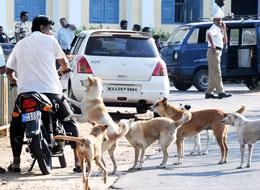
Vandana Anchalia wants to help change the world, one dog at a time.
The Singaporean lass, is the founder of Kannan Animal Welfare (KAW) — an animal welfare project of the Kannan foundation — which has a care centre based out of Noida, near New Delhi that houses around 80-90 resident dogs.
Many of the abandoned dogs are now finding new homes in Canada and the US, reports the Hindustan Times.
“There’s great demand for adoption of desi dogs and other breeds abroad, and we tie up with rehoming partners to help us get these dogs to their new homes,” said Anchalia.
We’ve sent about 48 dogs till now, and none of them have been returned to us..plus I get regular updates about them, too.”
“The choice of adopting a desi dog was not something I consciously decided. We wanted another dog, and we wanted a special needs dog. In my search, I found my first desi girl, and once she was with us we fell in love with her. After that, it was an easy choice to adopt another desi with special needs,” said, Mary-Ann Eastman from Canada, in a message to KAW.
“My partner, Cam and I adopted our desi dog (originally called Sugar, now named Bowie) from KAW last March during a trip to India. I had been there 10 years earlier, and was really affected by the stray dog problem, so I made a promise to myself to come back at some point and adopt a little Indian desi pup. We had considered adopting another breed or mixed dog from Canada, but desi dogs are just so incredibly sweet, smart and aware, and we fell in love with our Bowie right away. He has brought so much joy into our lives over the past year and we’re so grateful for everything KAW did in organizing the adoption for us,” wrote Sarah Dickens from Canada.
An estimated 35 million stray dogs live in India and according to World Health Organisation (WHO) India faces about 18,000 to 20,000 cases of rabies every year. According to the WHO report an estimated 45 pc of all deaths from rabies occur in South- East Asia out of which about 36 pc of the world’s deaths from rabies happen in India itself.
The incidents from rabies in India have been constant for a decade, without any obvious declining trend, and reported incidence is probably an underestimation of true incidence because in India rabies is still not a notifiable disease.
In March 2016, civic authorities from Mumbai disclosed in the Supreme Court that dog bites in Mumbai have taken 434 lives in the time period 1994 to 2015. According to reports more than 1.3 million people were bitten by dogs in Mumbai during this period. In November 2016, the Supreme Court ordered the Kerala government to stop the vigilante from the slaughter of stray dogs.
Kolkata has a population of more than 80,000 stray dogs, according to the NGOs in the city. But the number is constantly rising due to a sluggish sterilisation drive. Activists in the city blame the administration for not pushing animal control policies, including spaying and neutering, which would have possibly helped avoid some of the current problems. Similarly in Vijayawada, Andhra Pradesh there are around 16,000 stray dogs in the city and according to officials the population has increased by 3,000 due to failed efforts by civic bodies in administering sterilisation and other vaccinations to reduce the population.
The biggest reason behind the problem is open garbage. Stray dogs rely on garbage while hunting for eatables. Countries that have garbage kept in bins and are cleaned regularly see lesser number of stray dogs.
India also has fewer government and NGO services that deal with stray dogs. In many developed and developing countries, the government spays and neuters stray dogs to decrease their population growth. Many countries have organisations like Animal Control, the Humane Society, the SPCA, private shelters, and rescue organisations, that take care of the stray dog problems. The Indian government has to come up with large scale interventions and organisations that can deal with the problem. Rules for prevention of cruelty to animals that came in 1960 got amended in the year 2017, but the judicious implementation of regulations needs to be renewed and implemented in a more organised way.
Kashika Arora an entrepreneur of pet management company called Kashika’s Pampered Paws, based in Kolkata told Media India Group, “Stray the word itself is wrong. They are our Indian breeds, which we Indians don’t want to accept. People should drive safely so as to not hurt or kill them and also adopt street dogs rather than adopting a fancy breed.”
Meanwhile, a team of scientists in India is investigating why packs of stray dogs in villages near the north Indian town of Sitapur have mysteriously started killing children.
In just a week in May, six children between 5 and 12 years old were killed by strays while more than two dozen other children have been injured in attacks.
The attacks have terrorized the town. According to local reports, school attendance has dropped and residents say they believe the killer beasts are hyenas, not dogs. Vigilante dog-catching squads have started shooting and strangling animals, while local authorities have recruited police officers, municipal workers and a team of expert monkey catchers to apprehend the strays.
The World Wildlife Fund and the Indian Veterinary Research Institute have sent teams to figure out what has turned the dogs into child killers.
Link to original article: https://www.southasianpost.com/article/7260-canadians-flock-adopt-stray-dogs-india.html

